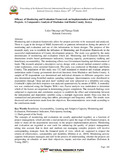Efficacy of Monitoring and Evaluation Framework on Implementation of Development Projects. A Comparative Analysis of Machakos And Embu County, Kenya
Abstract
Monitoring and evaluation frameworks allow for project activities to be measured and analyzed.
There is a gap in the design of M&E frameworks to generate information during the process of
monitoring and evaluation and use of this information in future designs. The purpose of this
research study was to establish the influence of Monitoring and Evaluation Framework in the
successful implementation of County development projects. The study was guided by the main
determinants of monitoring and evaluation which are: Monitoring and Evaluation framework
dimensions results based performance indicators, learning capacity, participatory tracking and
beneficiary accountability. The moderating effects was Government funding and disbursement of
funds. The research adopted a descriptive survey design with a mixed method centered within a
wider exploratory, cross-sectional framework. The study was conducted in Machakos and Embu
County. The population of this study was 132 staff mandated to monitor and evaluate projects
undertaken under County government devolved functions from Machakos and Embu County. A
sample of 99 respondents was determined and individual elements in different categories were
also determined using Stratified random sampling technique. Questionnaires were distributed to
respondents through “drop and pick later” method and were subjected to a reliability test using
Cronbach’s alpha and their response was analyzed quantitatively by means of SPSS. A normality
test was conducted using the Shapiro Wilk’s test. Factor analysis was undertaken to determine
which of the factors are important in determining project completion. The research findings were
subjected to regression and correlation analysis to establish the effect and relationship between
the independent and dependent variables using a multiple regression model. Data was then be
summarized and presented using data tables, percentages and frequency tables. The results were
discussed and conclusions made from the objectives. Recommendations were made according to
the conclusions made.

